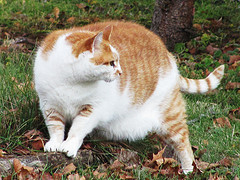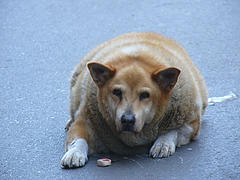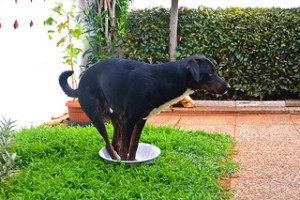 According to leading veterinarians, pet obesity is becoming an epidemic and should be a top health concern for pets. It is estimated that 54 million cats and 34 million dogs in the US are clinically obese. Many pet owners struggle with keeping their pets at an ideal weight.
According to leading veterinarians, pet obesity is becoming an epidemic and should be a top health concern for pets. It is estimated that 54 million cats and 34 million dogs in the US are clinically obese. Many pet owners struggle with keeping their pets at an ideal weight.
We’ll admit, it can be sometimes hard to deny those puppy dog eyes and we just want our pets to be happy, right? So why can’t they have a few extra treats if they want them? Unfortunately, a few extra pounds can be detrimental.
The excess weight on our pets can cause a variety of other health problems, the same way obesity can have adverse effects on human health. A few extra pounds on a dog may not seem like anything to worry about, but the added weight can exacerbate arthritis, cause joint and bone issues, and it can greatly increase the possibility that your pet will develop diabetes or cardiac/respiratory disease. Thier immune systems can be diminished, making their ability to fight off other illnesses and disease.
It’s best to learn how to prevent pet obesity before weight related complications arise, because even if your pet loses weight, the damage may be irreversible.
Is My Pet Obese?
The easiest way to tell if your pet is overweight is to feel the ribs. If you can feel the individual rib bones easily your pet is most likely not overweight. The Healthy Weight Calculator from PetMD.com is also a great tool that can help you determine your pet’s proper healthy weight.
 Causes of Obesity
Causes of Obesity
There isn’t just one cause of pet obesity; there are quite a few factors involved! Our pets rely on us to feed them properly and give them the proper amount of physical activity to stay fit. They don’t think about what they eat, if they are overeating and how it may effect their health. If your dogs are like mine, they will accept any treat or table scrap offered without hesitation.
Most pets, including cats, need a fair amount of physical activity each day in order for them to stay fit; a sedentary lifestyle combined with poor nutrition is the number one cause of pet obesity. When deciding what and how much to feed your pets, keep their activity level in mind. The amount of food listed in the instructions on pet food labels may contain too many calories for your pet, especially if they aren’t very active.
Many pet parents ‘free feed’ their animals, in other words, their animals have constant access to food throughout the day. Some pets, though few and far between, are good at self-regulating and stop eating when they are full, while others will scarf down food whenever it’s available. It’s important to measure out the amount of food that your pets eat in a day (including treats and table scraps!), so you can monitor their intake.
Some specific breeds may be more susceptible to obesity. These breeds may be predisposed to conditions including naturally slow metabolism and hormonal disorders that make them more likely to gain weight.
Having a pet spayed or neutered also causes metabolism to slow, and after the procedure many pets gain weight, but the benefits of spaying and neutering your pets far outweigh the negatives.
5 Simple Steps to Prevent Pet Obesity
1. Know Your Pets’ Caloric Requirements
The average human needs a 2000 calorie diet to maintain their weight and receive adequate nutrition, our pets need far less. Refer to the following chart to estimate the number of calories that your pets’ require. For a more accurate estimate of your dog’s require caloric intake, visit the Dog Food Advisor’s Dog Food Calculator.
2. Portion Control
Use a smaller scoop and a smaller food bowl. Studies have shown that the size of your pet’s bowl and food scoop affects the amount of food that you feed your pet. If you have a Chihuahua and you are using an 8 inch bowl, you are probably going to overfeed Chico quite a bit. It all has to with how much food you perceive is in the bowl. If you used a small dish, you would perceive that you were feeding more food. If you are trying to help your pet lose weight, using a smaller bowl and a smaller scoop will go a long way towards helping them reach their goals.
3. Keep Track of Snacks
Many people are feeding the right amount of kibble for their dog’s appropriate weight, but they might also be feeding them a dozen milk bones or bites of “people food” throughout the day. Don’t forget that the treats and snacks that you feed your pet throughout the day should also count towards their daily calorie intake. That includes treats used for training! If you pet isn’t a picky eater, try using carrot sticks, apple slices or celery as a substitute for high calorie treats. They’re natural, whole foods and low in calories, and most pets love them.
4. Several Smaller Meals
If you feel that your pet seems hungry throughout the day, try dividing up your pet’s meals into smaller, more frequent meals throughout the day. Before you schedule your pet for 4 meals a day, a word of caution: your pet has probably trained you into feeding him when he does something specific. For example: Bear knows that if he sits next to the treat jar looking sad, I will probably hand him a cookie or if my cats meow at the top of their lungs for an hour, I’ll provide them with a scoop of kibble or two. My pets are likely not actually hungry, but they are repeating behaviors that in the past has been rewarded with a treat or extra meal. Try not to give in, redirect them with a game or go for a quick walk if they’re particularly relentless.
 5. Veggies!
5. Veggies!
Supplementing meals with fresh or frozen vegetables or low calorie fruits can be a big help. The added fiber in the vegetables will help your pet feel fuller, longer. Don’t feed your pet foods that may be toxic, like tomatoes, onions, mushrooms, garlic, avocados, raw or green potatoes, grapes, raisins, or any pits, stems or seeds from fruits. I also tend avoid corn, since it is a common pet allergen.
You should always consult your veterinarian before putting your dog on a special diet or exercise program. The first, most important and often most difficult step is is to control the amount of food your pet is allowed to eat. If you cannot excercise your pet as often as necessary or if your dog has a condition that hinders activity and natural weight maintenance, your vet can often make recommendations to help with your situation.
A slow and steady approach is the healthiest, just as with people in the same predicament. Make slow changes to your pet’s diet and exercise regime. Your pet shouldn’t lose more than 1-2% of body weight per week.
Maintaining a healthy body weight and an active lifestyle will help you keep your pet at it’s happiest and healthiest for years to come!






 That Pet Blog That Pet Place Pet Blog
That Pet Blog That Pet Place Pet Blog

![stockxpertcom_id100161_size0[1]](http://www.thatpetblog.com/wp-content/stockxpertcom_id100161_size01-300x189.jpg)








